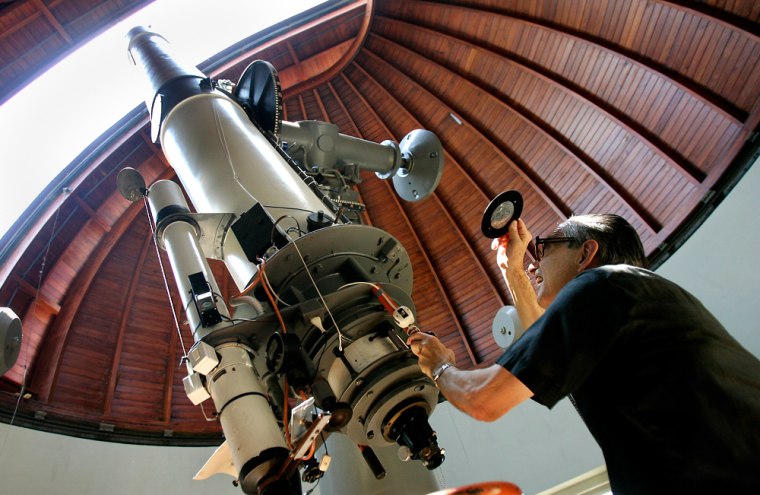Everyone knows the Vatican is interested in Heaven but it may come as a surprise to some that it is also interested in the heavens.
In this sleepy lakeside village away from the noise and haste of Rome, the Vatican is helping to train tomorrow's astronomers -- regardless of their religious beliefs.
For the past 20 years, the Vatican Observatory, one of the world's oldest astronomical institutes, has selected young, promising scholars for courses at the papal summer palace.
"The Vatican wants to show its appreciation for science," said Father Chris Corbally, a soft-spoken Jesuit from Britain who is the observatory's vice-director and dean of its international summer school.
"Science is an important value in human life and therefore it is important to the Catholic Church," he said on the palace terrace during a break in classes.
Popes have been intertwined with astronomy for centuries.
The Inquisition condemned Galileo for insisting that the earth revolved around the sun. It was just one step in a tango between faith and science that still goes on today.
Pope Gregory XIII, on advice of scientists, changed the calendar in 1582 to correct the errors of the Julian calendar.
By the end of the 1700s, three Vatican-sponsored observatories were studying the stars from Rome.
In 1891, Pope Leo XIII formally established the Vatican Observatory inside the Vatican behind St Peter's dome. By 1935, Rome's urban sprawl made stargazing difficult, so Pius XI moved the observatory to the summer palace south of Italy's capital.
'Galileo walks here'
"This place is fantastic," said Sarah Chamberlain, 25, a Ph.D. from Australia, one of 25 students selected from more than 200 applicants for this year's courses on "astrobiology," or the search for evidence of life forms on other planets.
"We have very little history in my country but here you just breathe the history. There are books written in 1667 by some of the people that I have only read about or have been taught about in first year physics. To be in this place is absolutely fantastic. Galileo walks here," she said.
The one-month programmed does not make for light summer reading. World-renowned scientists from Europe and the United States teach topics such as "nucleosynthesis and stellar evolution" and "biomarkers for in-situ and telescopic detection".
"These students come here because they want to learn more science," said Corbally.
"The whole environment of the place invites reflection. But we don't ask what their faith is, or if they have any. What we do ask is what quality of person they are, what enthusiasm they have, what is the promise of continuing in research careers in astronomy or in astrobiology," he said.
Corbally said some 85 percent of alumni who have attended the summer school are still in science.
This year's students come from 19 countries. No more than two are allowed from each country to give the student body a representational mix of industrialized and developing nations.
"Here religion and science are coming together and supporting each other," said Mascia Khristoforova, 21, from Kazan in Russia.
Students from non-industrialized countries get scholarships covering some 75 percent of travel and living expenses.
"We want everyone to feel completely equal," said Corbally.
This year, organizers said bureaucratic slowness at the Italian embassy in Beijing prevented two Chinese students from getting visas in time for the courses. "It was a real loss for China and for the students," Corbally said.
There are two giant telescopes on the roof, each covered with wood and steel domes visible for miles from the palace, built on the ruins of Roman emperor Domitian's residence.
While the headquarters of the Vatican Observatory remains in the papal palace, the principal observing since 1981 has been done at the Vatican's research institute in Tucson, Arizona, one of the world's largest international astronomy centers.
Stardust memories
Father Emmanuel Carreira, a Jesuit who taught physics for decades in the United States and his native Spain, is a link between the old and the new worlds.
He shows a visitor the giant telescope -- built in 1935 but still going strong -- with the pride of someone showing off a vintage pre-war Rolls Royce that no-one would ever dream of equipping with an on-board computer.
"Most astronomy now is not done with observing with your eyes," he laments.
"You observe with electronic detectors, digital cameras and all kinds of things and then you look at a computer screen. Even if many of them are close to getting their doctorate, most of the students here never have had the experience of actually looking and seeing something through a telescope," he said.
"On the first day, when I showed the new students the moon, this girl from Sweden almost cried," he said.
"She had never seen the moon. She had never seen how beautiful it is and how you can actually see the craters and the mountains and the shadows. It is a real heavenly body and she had only seen it in photographs."
For both the young student and the old professor, it was one of those stardust memories they will never forget.
